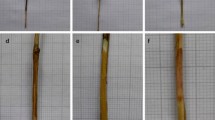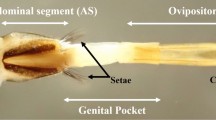Abstract
Leguminous trees are widely used to support climbers such as black pepper (Piper nigrum L.) and vanilla (Vanilla planifolia Andr.), to provide shade to crops and to maintain soil fertility. Pruning or pollarding provides the means to maximize benefits from the trees, particularly through the production of biomass as a soil amendment. At the same time, excessive shading is reduced. In order to quantify the degree of shading of black pepper by the support trees during a six-month pollarding cycle, this study monitored crown development (part I) and light transmission (part II) of three widely used species,Erythrina berteroana Urban,E. fusca Loureiro andGliricidia sepium (Jacq.) Steud.
The two sites were in the humid Atlantic Lowlands of Talamanca, southern Costa Rica (mean annual rainfall 2460 mm, no distinct dry season), on alluvial soils (typic Tropofluvents) with low levels of K, P, Mn and Zn. Two-year-old trees, that had been established from cuttings as live supports for black pepper, were used for the study. They were pollarded twice per year. The variables measured/estimated monthly were: stem diameter at breast height (dbh); height, foliated height, depth, diameter, leaf area and leaf biomass of crowns; length, diameter, number and inclination of branches. Leaf nutrient contents were also determined.
Following pollarding,G. sepium was the first to resprout, followed byE. berteroana andE. fusca. G. sepium with its few but erect and long branches had slender, columnar crowns. while those ofE. berteroana andE. fusca were more spherical. Four months after pollarding,G. sepium started shedding leaves at the base of its branches. Average crown diameter after six months were 2.2 m forE. berteroana, 1.9 m forE. fusca and 1.5 m forG. sepium; average crown depths after six months were 2.8 m, 2.1 m, and 2.7 m, respectively, for the three species. For 1600 trees ha−1 and two prunings per year, foliar biomass production from prunings alone (i.e., without litter fall), calculated from regressions with length and basal diameter of branches as independent variables, was 3.8 t, 3.4 t and 2.3 t dry matter ha−1 a−1 forE. berteroana, E. fusca andG. sepium, respectively; these estimates agreed well with measured values. The corresponding N contents were 146 kg, 124 kg and 90 kg, respectively. While N contributions from the prunings exceeded 50% of the fertilizer recommendations for black pepper, the contributions were <10% for P and <40% for K. Linear regressions between leaf area and branch dimensions, and quadratic regressions between foliar biomass and crown diameter showed high coefficients of determination (0.83>R 2>0.99). Correlations between foliar biomass, dbh, and dbh increments were generally weak. Conclusions from the study appear to be valid also for other agroforestry systems where the same species are planted under similar ecological conditions for reasons other than as live supports.
Resumen
Los árboles leguminosos se usan frecuentamente como soportes vivos para plantas trepadoras como pimienta negra (Piper nigrum L.) y vainilla (Vanilla planifolia Andr.), para dar sombra y para reducir el desgaste de los suelos. La poda de los árboles reduce la cantidad mantener la fertilidad de sombra y produce biomasa que sirve como enmiendas. Con el objectivo de cuantificar el grado del sombreado de pimienta negra por los árboles durante un cíclo de poda de seis meses, se monitoreó en este estudio el desarrollo de la copa (parte I) y la transmisión de luz (parte II) de tres especies usados como soportes vivos:Erythrina berteroana Urban,E. fusca Loureiro yGliricidia sepium (Jacq) Steud.
Los dos sitios estan en la zona tropical húmeda de Talamanca Baja, en el sureste de Costa Rica (precipitación promedia 2460 mm, sin estación seca) en suelos aluviales (Typic Tropofluvents) y pobres en K, P, Mn y Zn. Los árboles fueron establecidos de estacas. Cuando este estudio empezó, los árboles tenían dos años de edad y fueron podados dos veces por año. Los parámetros medidos ó estimados mensualmente fueron: diámetro del tronco a la altura del pecho (DAP); altura, altura foliada, profundidad, diámetro, área foliar y biomasa foliar de las copas; largo, diámetro, número y inclinación de las ramas. Además se determinó el contenido de nutrientes de las hojas.
Despues de la poda,G. sepium fue el primero en rebrotar, seguido porE. berteroana yE. fusca. G. sepium con sus ramas escasas pero largas y erectas, formó una copa delgada y columnar, mientras que las copas deE. berteroana yE. fusca fueron más esféricas. Cuatro meses después de la poda,G. sepium empezó a perder las hojas en la base de sus ramas. El promedio del diámetro de la copa después de seis meses fue de 2.2 m paraE. berteroana, 1.9 m paraE. fusca y 1.5 m paraG. sepium; el promedio de la profundidad de la copa después de seis meses fú de 2.8 m, 2.1 m y 2.7 m, respectivamente para las tres especies. Para 1600 árboles ha−1 y dos podas por año, la producción estimada de biomasa foliar de la poda (sin tomar en cuenta la hojarasca caída antes), calculada de regresiónes con el largo y el diámetro basal de las ramas como variables independientes, fue de 3.8 t, 3.4 t y 2.3 t de matéria seca ha−1 a−1 paraE. berteroana, E. fusca yG. sepium, respectivamente; estos valores calculados concordaron bien con valores medidos. El contenido de N correspondiente fué de 146 kg, 124 kg, y 90 kg, respectivamente. Mientras que la contribución de N procedente de las podas excedió 50% de una recomendación de fertilización común para pimienta negra, la contribución de P fue inferior al 10%, y menos del 40% para K. Regresiones lineales entre área foliar y las dimensiones de la ramas, y regresiones cuadraticas entre biomasa foliar y el diámetro de la copa mostraron altos coeficientes de determinación (0.83>R 2>0,99). Las correlaciones entre biomasa foliar, el DAP y incrementos del DAP fueron generalmente débiles. Las conclusiones de éste estudio parecen válidas tambien para sistemas agroforestales donde las especies estudiadas son plantadas bajo condiciones ecológicas similares para propósitos diferentes de como soportes vivos.
Similar content being viewed by others
References
Adejumo JO and Ademosun AA (1985) Effect of plant age at harvest, and of cutting time, frequency and height on the dry matter yield and nutritive value ofGliricidia sepium andCajanus cajan. Journal of Animal Production Research 5(1): 1–11
Béliard CA (1984a) Producción de biomasa deGliricidia sepium (Jacq.) Stued. en cercas vivas bajo tres frecuencias de poda (tres, seis y nueve meses). Tesis Mag. Sc., Univ de Costa Rica/CATIE, Turrialba, Costa Rica
Béliard CA (1984b) Tablas de rendimiento de rebrotes (leña y forraje) en cercas vivas deGliricidia sepium en la zona de Siquirres, Costa Rica. INFORAT, CATIE, Turrialba, Costa Rica
Bergmann W (1988) Ernährungsstörungen bei Kulturpflanzen (2nd ed). Gustav Fischer Verlag, Stuttgart, 762 pp
De Geus Jan G (1973) Fertilizer Guide for the Tropics and Subtropics (2nd ed). Centre d'Étude de l'Azote, Zürich, 774 pp
Díaz-Romeu R and Hunter A (1982) Metodología de muestreo de suelos, analysis quimico de suelos y tejido vegetal y de investigaciones en invernadero. Serie materiales de ensenañza No. 12. CATIE, Turrialba, Costa Rica, 61 pp
Drechsel P and Zech W (1991) Foliar nutrient levels of broad-leaved tropical trees a abular review. Plant and Soil 131: 29–46
Erdmann TK, Nair PKR and Kang BT (1993) Effects of cutting frequency and cutting height on reserve carbohydrates inGliricidia sepium (Jacq.) Walp. Forest Ecology and Management 57: 45–60
Ewel JJ (1986) Designing agricultural ecosystems for the humid tropics. Annual Review of Ecology and Systematics 17: 245–71
Ghuman BS and Lal R (1990) Nutrient addition into soil by leaves ofCassia siamea andGliricidia sepium grown on an ultisol in Southern Nigeria. Agroforestry Systems 10: 131–33
Herrera W (1985) Vegetación y Clima de Costa Rica. Editorial Universidad Estatal a Distancia. San José, Costa Rica
Hill J (1980) The remobilization of nutrients from leaves. Journal of Plant Nutrition 2: 407–444
IDRC (International Development Research Centre) (1989)Erythrina spp. — Fase I. Informe técnico final del proyecto. Informe 217s, CATIE, Turrialba, Costa Rica, 185 pp
Jordan CF (1985) Nutrient Cycling in Tropical Forest Ecosystems. Wiley & Sons, Chichester, 190 pp
Kays JS and Canham CD (1991) Effects of time and frequency of cutting on hardwood root reserves and sprout growth. Forest Science 37: 524–539
MacArthur JD (1980) Some characteristics of farming in a tropical environment. In: Ruthernberg H, ed, Farming Systems in the Tropics (3rd ed) pp 19–29 Clarendon Press, Oxford, 424 pp
Maistre J (1964) Les Plantes a Épices, Maisonneuve & Larose, Paris
Mathai CK and Sastry KS (1988) Productivity of black pepper vines (Piper nigrum L.) as influenced by the light availability during pre-flowering stage. Comparative Physiology and Ecology 13(3): 97–102
Müller-Sämann KM (1986) Bodenfruchtbarkeit und standortgerechte Landwirtschaft. Eschborn, Germany. Schriftenreihe der GTZ, No 195, 559 pp
Mulongoy K and Meersch van der MK (1988) Nitrogen contribution by leucaena (Leucaena leucocephala) prunings to maize in an alley cropping system. Biology and Fertility of Soils 6: 282–285
Muschler RG (1991) Crown Development and Light Transmission of three leguminous Tree Species in an Agroforestry System in Costa Rica. MSc Thesis, Gainesville, University of Florida, 139 pp
Muschler RG (forthcoming) Light transmission through crowns of pollardedErythrina berteroana, E. fusca andGliricidia sepium in the humid lowlands of Costa Rica. Agroforestry Systems
PNUD/OIT/ITCO (1979) La Pimienta (Piper nigrum L.) — Situation mundial y perspectivas para su explotacion en Costa Rica. Documento preparado por Proyecto COS/72/018 ‘Empleo y Desarrollo Rural', PNUP/OIT/ITCO, San José, Costa Rica, 38 pp
Russo RO and Budowski G (1986) Effect of pollarding frequency on biomass ofErythrina poeppigiana as a coffee shade tree. Agroforestry Systems 4: 145–162
Sanchez PA, Palm CA, Szott LT, Cuevas E and Lal R (1989) Organic input management in tropical agroecosystems. In: Coleman DC, Oades JM and Uehara G, eds, Dynamics of Soil Organic Matter in Tropical Ecosystems, pp 125–152, Honolulu, University of Hawaii
Weischet W (1980) Die ökologische Benachteiligung der Tropen, Stuttgart, Teubner, 127 pp
Young A (1989) Agroforestry for Soil Conservation. Wallingford, UK, CAB International, 276 pp
Zech W, Haumaier L and Hempfling R (1990) Ecological aspects of soil organic matter in tropical land use. In: MacCarthy P, Clapp CE, Malcolm RL and Bloom PR, eds, Humic Substances in Soil and Crop Sciences, pp 187–202. American Society of Agronomy, Madison, WI
Author information
Authors and Affiliations
Rights and permissions
About this article
Cite this article
Muschler, R.G., Nair, P.K.R. & Meléndez, L. Crown development and biomass production of pollardedErythrina berteroana, E. fusca andGliricidia sepium in the humid tropical lowlands of Costa Rica. Agroforest Syst 24, 123–143 (1993). https://doi.org/10.1007/BF00706887
Issue Date:
DOI: https://doi.org/10.1007/BF00706887




